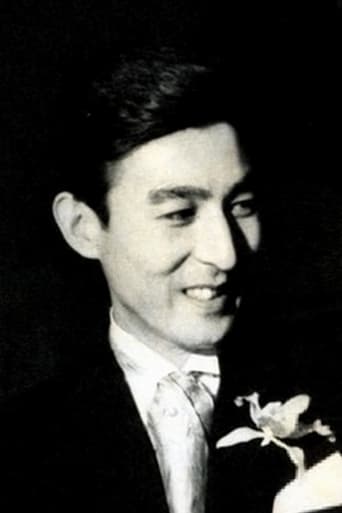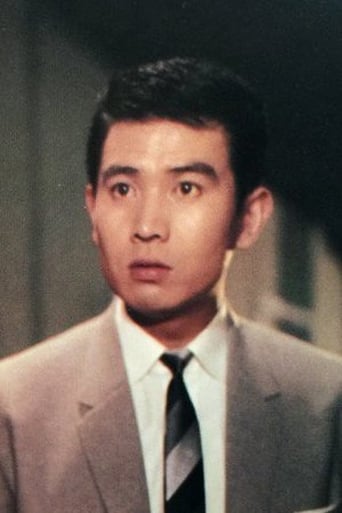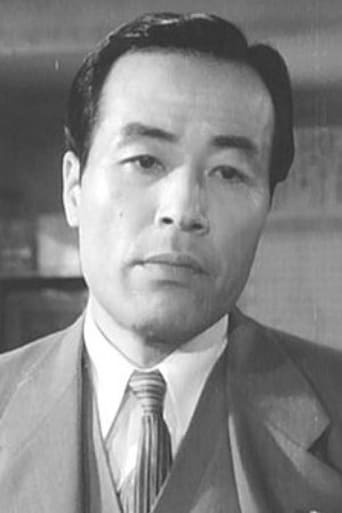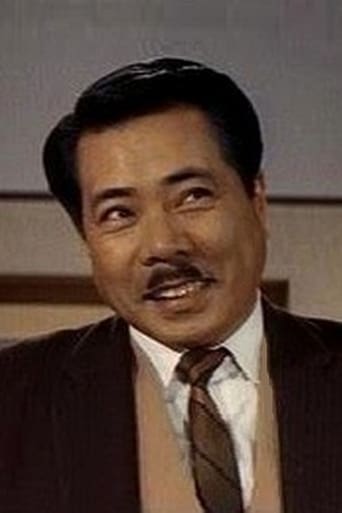mark.waltz
Utilizing the most offensive dubbing of Japanese I've ever heard (even in Godzilla movies), this actually seemed to have been a pretty good movie until Eng-rish speaking dubbing took over to turn this into a real cheesy mess. The science fiction element of the plot is actually very interesting with nuclear reactions to dumping at sea causes some people to become walking water fountains, covered in a green slimy mess that when it encounters human flesh causes that victim to melt like the wicked witch of the west. The moments of these innocent victims being attacked is very frightening, and there is also a scary looking scene where several of these green globs gather together on what appears to be some sort of ghost ship. In its original language, it would probably rank in a rating a bit higher (being technically much better than many of the Godzilla and other various monster films), but putting in these silly voices to bring it to English speaking audiences just makes it outrageously bad, both with the dubbing and its outrageously laughable (if still one dimensional) stereotyping of how Japanese people speak the English language.
TheUnknown837-1
Even though it is not, in totality, a great film, Ishiro Honda's "The H-Man" (or "Beauty and the Liquid People" as it was named in its own country) has some remarkable things in it. The cast is a harvest of reliable acting talents; the movie features some tremendously effective special effects; and the photography is luscious and rich with color. What is most remarkable about "The H-Man," however, is the way it combines two radically different genres, and yet gives each genre its due and moments to shine. If the movie were just a horror story or just a yakuza melodrama, it still would have been an interesting picture. And once combined, they form one of Toho's most intriguing, if uneven, efforts to date.We also get Honda's usual symbolism, once again on the atomic bomb. And once again, as in "Mothra," it is applied in a rather subtle manner. Honda opens the movie with an eye-popping, wholly unexpected nuclear explosion and then shies away from talking about his message for quite a spell. The eponymous H-Men, a race of liquid organisms that can take the shape of humans and dissolve any living thing they come into contact with, are supposedly an aftereffect from nuclear testing in the South Pacific. When they disintegrate a person, leaving nothing but their clothes behind, the area is teeming with radiation. But Honda does not take the cheap shot; he does not drag out his story with chatter and contemplation about man messing with the balance of the world. His only lapse is at the end, when he allows Takashi Kimura's screenplay to blabber, via an unimportant supporting character, about how man should stop tinkering with nuclear energy, else let the H-Men take over in the future. Here, the allegory comes on a bit thick, and the end monologue does not come across as hauntingly fresh as it was in "Godzilla," but instead, on the pretentious side.For the most part, however, both Honda and Kimura allow the double-edged plot to take center-stage. It's a combination I very much enjoyed, particularly the half about the Japanese gangsters and the police department's attempts to drag them into the gutter. There are some terrific character actors in the film's police force, including Akihiko Hirata, Yoshio Tsuchiya and Eitaro Ozawa. Now granted, the policemen are not developed as really anything but policemen – straight-shooters who seldom smile and scoff at the suggestion that liquid-men are running amok in Tokyo – but the actors breathe such life into them, as to make them interesting. Take Yoshifumi Tajima, for instance. He plays the most skeptic cop you could ask for – no real depth of character – and yet when he winds up being killed by one of the monsters, I actually felt a bit down. I liked that character, or at least Tajima's interpretation of that character.If only there was more life put into the love story. And this is what I think disqualifies "The H-Man" from being a truly great film. The movie would like us to care about the couple (a yakuza's moll and a daring young scientist trying to warn the cops of the impending danger), but the emotional involvements adds up to zero. This is not a reflection on the two performers. Kenji Sahara and Yumi Shirakawa are superb talents and even proved two years before, in Honda's better film "Rodan," that they can effectively play lovers on film. But "Rodan" gave them things to do together, moments to shine in each other's company. The screenplay of "The H-Man" asks us to believe in their chemistry after they meet very briefly, pass a few insignificant words, and when Shirakawa sobs into Sahara's shoulder. I really wanted more meaningful scenes between them.Shirakawa, on the other hand, does run away with the show, and she does have the best-rounded character. From the get-go, we like this soft-eyed, confused girl, and we sympathize with her when both rival gangsters and skeptical detectives refuse to quit hounding her. And at the end, when a snarling gangster starts dragging her through the sewers of Tokyo, all the while getting themselves surrounded by liquid-men, I felt myself really worrying about what would become of her, and really hoping her captor would get his comeuppance.But the horror story works well, too. Most of all, because how Kimura's screenplay depicts the H-Men as mostly a predatory substance, maintaining very little of what made them human to begin with. It's not at all like the cartoonish demeanor of the organism from "Space Amoeba." The H-Men attack like parasites ensuring their own survival. When one of them takes the form of a man, in which case they glow with a tremendous neon aura, they are dazzling. But I really like how most of the time, they melt down into a moving sludge that crawls up and down the walls. There are some laughable moments (such as a freeze-frame shot of a victim while animated sludge consumes her body, mercifully cut from the U.S. print of the picture), but the good moments far outnumber the bad ones. Part of the fun of these special effects is just wondering how, given 1950s technology, the staff could pull it off. Especially when sludge starts crawling out of a pool of water and we cannot see any signs of a reverse-speed shot. Aided by Masaru Sato's gentle yet ominous music, the monsters do have a presence of their own.It is such a relief to finally have Ishiro Honda's "The H-Man" widely available in the United States. For the picture really is a delightful little experience. Even its U.S. print maintains the fun, making a few small edits for pacing and completely honoring the original premise. With some reservations, I would even go so far as to call this one of my more favorite Toho movies of the 50s.
LeonLouisRicci
The Japanese horror and sci-fi films from the 50's never really reached any sort of high level of artistic quality other than superficial curiosity. Almost always a notch below even the least of its American and UK cousins.The movies did have a surreal quality although most of that seems to stem from the cultural and cinematic differences in style, approach, and mindset. The best of the line just didn't have that crisp, clean veneer that the domestic releases contained. It is probably this shortcoming that gives these films that other-worldly wonder that the kids of that era and film buffs today find so fascinating.The H-Man has a few eerie scenes and some somewhat different looking, if not cheap imitations, of American nightclub gangsters and performers (a forced assimilation of their conquerors pop culture). But overall it is talkie and rather vapid. At least it is a mild diversion from the rubber suit, erector set extravaganzas.
Michael_Elliott
H-Man, The (1958) ** (out of 4) Toho film has some excellent special effects but a story that made me want to punch the television. A man gets hit by a car but when the driver gets out to check on him he discovers that the man is gone and only his clothes remain. More and more stories of people being killed only to have their clothes remaining start piling up and soon it's learned that a blob-like substance is doing the killings. This Japanese film, from the team who brought us GODZILLA, is pretty much another version of THE BLOB and while there are some great moments we also get sucked into some pretty bad ones. I've often complained that the Godzilla films were weak because they didn't center their attention on the monsters and that holds true here as well because we get a subplot of gangsters, which ends up taking up nearly an hour of the 79-minute running time. The monster really doesn't take center stage till nearly the 50-minute mark, which is just crazy because of how good it is. There's an early sequence on a ship that is highly effective but moments like these are few and far between as we get too much dialogue with a boring subplot. The special effects for the blob creature are quite good and better than what we saw in the earlier American classic. I watched the P&S, American dubbed version, which was recently on Turner Classic Movies but will revisit the film when Columbia releases it later in the year. Rumored to include the Japanese version I will certainly give it a second take in its original language.





